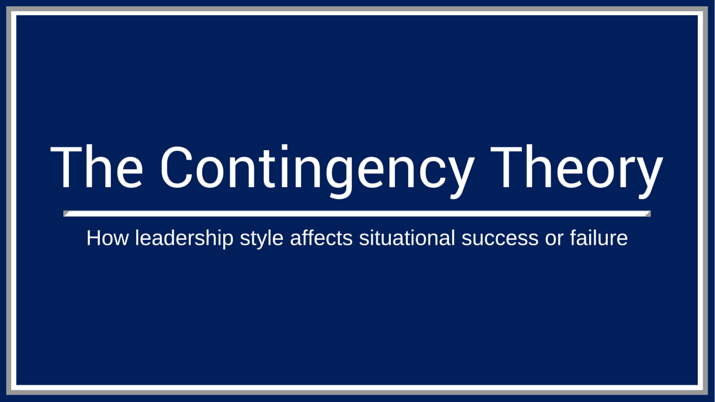The Contingency Theory of Leadership Explained

Last Updated January 9, 2015
There are many schools of thought that seek to explain leadership and define what is required to excel when wearing the mantle of power. Leadership and the distinct qualities that enable some to rise to the pinnacle of success while others remain followers are the focus of much debate. Even in general terms, scholars don’t always see eye-to-eye when defining how leaders rise and what is required to help them achieve their goals. This is demonstrated by the numerous sub-theories that have evolved from the contingency theory of leadership.
What is the Contingency Theory of Leadership?
The contingency theory of leadership puts forth the idea that the success of a leader hinges on the specific situation at hand. Certain factors come into play that define whether a particular leader or leadership style will be effective for the given situation. Those factors include the task, the personality of the leader and the composition of the group that is meant to be led. Its basic assumption is that leadership – success or failure – is situational.
Contingency Leadership Models
There are several different models of contingency leadership that fall under the general contingency theory umbrella. They include Fiedler’s Contingency Theory, the Situational Leadership Theory, the Path-Goal Theory and the Decision-Making Theory. While all of these contingency leadership models are similar on the surface, they each offer their own distinct views on leadership.
Fiedler’s Contingency Theory
Fiedler’s Contingency Theory puts forth the idea that effective leadership hinges not only on the style used by the leader, but also on the control held over the situation. In order to succeed, there must be strong leader-member relations. Leaders must also present tasks clearly and with goals and procedures outlined. They need to possess the ability to hand out punishments and rewards, as well.
Fiedler’s Contingency Theory only fits situations where groups are closely supervised and not team-based. It also uses a least preferred co-worker (LPC) scale to help determine the type of worker the leader least likes working with. This contingency model emphasizes the leader’s disposition as the main trait that defines the ability to lead.
Situational Leadership
More formally called Hersey and Blanchard’s Situational Leadership Theory, this contingency model focuses on leadership style and the maturity of those being led. Situational leadership theory puts forth the idea that leadership styles hinge on four behaviors: telling, selling, participating and delegating.
The maturity levels range from an incompetence or unwillingness to perform the task, to a willingness and ability to perform. The idea is that a successful leader will adapt leadership techniques to fit the maturity level of the group in question on a situational basis.
Path-Goal Theory
Path-Goal Theory combines two popular theories – goal-setting and expectancy – into one. It puts forth the idea that effective leaders help those in their direction attain their goals. Under this contingency model, leaders have the responsibility of making sure their subordinates have the support and information required to achieve the goals set forth. Essentially, this theory holds that effective leaders create clear paths to help their subordinates achieve goals and that they work to remove obstacles that stand in the way.
Decision-Making Theory
Also known as the Vroom-Yetton-Jago Decision-Making Model of Leadership, this contingency leadership model puts forth the idea that effective leaders size up situations, assess them and then determine how much support the group will give toward the effort, adjusting their preferred leadership style to fit.
Applying Contingency Theory in the Workplace
While contingency leadership models diverge on some points, they all share a common thread. The overlying viewpoint of the contingency theory of leadership is that effective leadership is contingent on the situation, task and people involved.
Different leaders, each with their own leadership style, will respond differently to a myriad of factors in the workplace. Among the factors that can affect a leader’s effectiveness are things like project scope, the size of their team, resources and deadlines. According to contingency theory, leaders will always find particular situations that challenge them and must be willing to acknowledge that their success partially depends on their circumstances.
To be great leaders for their teams, managers and supervisors may need to adapt their leadership style to the current situation. Leadership education and training can help professionals understand and respond to the complexities of the workplace and excel in their leadership roles.





